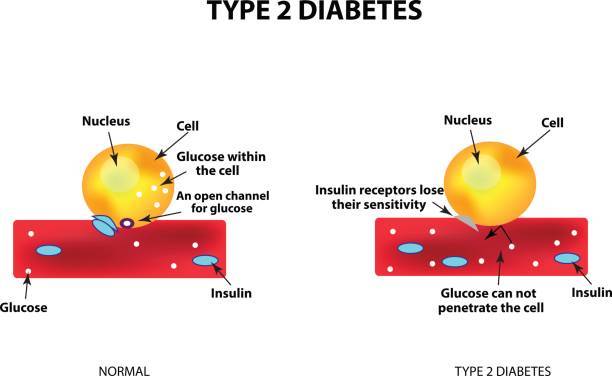Diabetes Mellitus: Exploring Type 1 & Type 2 Diabetes
**Introduction:**
Diabetes Mellitus, commonly known as diabetes, is a chronic metabolic disorder characterized by elevated levels of blood glucose (hyperglycemia) due to either insufficient insulin production, resistance to insulin action, or both. It is a major global health concern with significant implications for individual health and healthcare systems worldwide. This article aims to provide a comprehensive overview of both Type 1 and Type 2 diabetes, including their causes, symptoms, diagnosis, treatment, and management strategies.
**Type 1 Diabetes:**
1. **Causes:** Type 1 diabetes, formerly known as juvenile diabetes or insulin-dependent diabetes, is an autoimmune disorder in which the body's immune system mistakenly attacks and destroys the insulin-producing beta cells in the pancreas. The exact cause of this autoimmune reaction is not fully understood, but genetic predisposition and environmental factors such as viral infections may play a role.
2. **Symptoms:** Symptoms of Type 1 diabetes often develop rapidly and include excessive thirst, frequent urination, unexplained weight loss, extreme hunger, fatigue, irritability, and blurred vision. Without insulin therapy, Type 1 diabetes can lead to diabetic ketoacidosis (DKA), a life-threatening condition characterized by the buildup of ketones in the blood.
3. **Diagnosis:** Diagnosis of Type 1 diabetes is typically based on blood tests that measure fasting blood glucose levels and levels of glycated hemoglobin (HbA1c), which provides an indication of average blood glucose levels over the past two to three months. Additional tests may include oral glucose tolerance tests (OGTT) and antibody tests to detect autoimmune activity against pancreatic beta cells.
4. **Treatment:** The cornerstone of treatment for Type 1 diabetes is insulin therapy, which aims to replace the insulin that the body is unable to produce. This may involve multiple daily injections of insulin or the use of insulin pumps that deliver insulin continuously throughout the day. Blood glucose monitoring is essential for adjusting insulin doses and managing blood sugar levels effectively.
5. **Management:** In addition to insulin therapy, management of Type 1 diabetes involves maintaining a healthy lifestyle, including regular exercise, a balanced diet, and monitoring carbohydrate intake. Continuous glucose monitoring (CGM) systems and insulin pumps with integrated CGM capabilities can help individuals with Type 1 diabetes to better manage their blood glucose levels and reduce the risk of complications.
**Type 2 Diabetes:**
1. **Causes:** Type 2 diabetes, formerly known as adult-onset diabetes or non-insulin-dependent diabetes, is characterized by insulin resistance, where the body's cells become resistant to the effects of insulin, and impaired insulin secretion by the pancreas. Risk factors for Type 2 diabetes include obesity, sedentary lifestyle, unhealthy diet, genetics, and age.
2. **Symptoms:** Symptoms of Type 2 diabetes may develop gradually and include increased thirst, frequent urination, fatigue, blurred vision, slow wound healing, and recurrent infections. Many individuals with Type 2 diabetes may remain asymptomatic for years, leading to delayed diagnosis and complications.
3. **Diagnosis:** Diagnosis of Type 2 diabetes is similar to Type 1 diabetes and involves blood tests to measure fasting blood glucose levels, HbA1c levels, and possibly OGTT. Screening for risk factors such as obesity, high blood pressure, and dyslipidemia is also important in identifying individuals at risk of developing Type 2 diabetes.
4. **Treatment:** The management of Type 2 diabetes typically involves lifestyle modifications, including dietary changes, regular physical activity, weight management, and smoking cessation. Oral medications such as metformin, sulfonylureas, thiazolidinediones, and DPP-4 inhibitors may be prescribed to improve insulin sensitivity, stimulate insulin secretion, or reduce glucose production in the liver.
5. **Management:** In addition to lifestyle modifications and oral medications, some individuals with Type 2 diabetes may require insulin therapy to achieve glycemic control. Regular monitoring of blood glucose levels, blood pressure, and lipid levels is essential for managing Type 2 diabetes and reducing the risk of complications such as cardiovascular disease, kidney disease, and neuropathy.
**Conclusion:**
Diabetes Mellitus, encompassing both Type 1 and Type 2 diabetes, presents significant challenges for individuals, healthcare providers, and society as a whole. While Type 1 diabetes is primarily managed with insulin therapy, Type 2 diabetes often requires a multifaceted approach involving lifestyle modifications, oral medications, and possibly insulin therapy. Early diagnosis, appropriate treatment, and ongoing management are essential for achieving optimal glycemic control, preventing complications, and improving quality of life for individuals living with diabetes. Through education, awareness, and access to healthcare resources, we can work towards reducing the burden of diabetes and promoting healthier outcomes for affected individuals worldwide.


